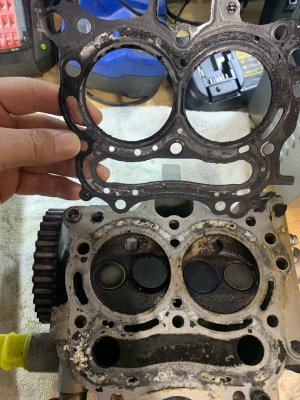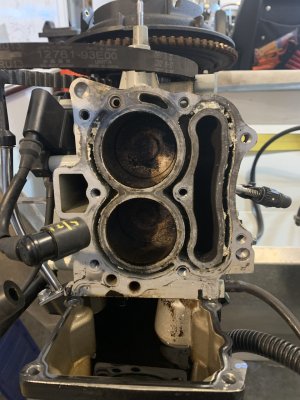You are using an out of date browser. It may not display this or other websites correctly.
You should upgrade or use an alternative browser.
You should upgrade or use an alternative browser.
Flushing outboards off the grid
- Thread starter Augie
- Start date
N2013
Well-Known Member
What and how do you do a hot soak?I recently had to deal with some salt blockages in a 2016 outboard that were causing it to overheat even at idle. The previous owner never flushed it. In addition to other routine maintenance, I removed all thermostats and poppet valves and hooked up a bilge pump to the flush port. I cycled salt away through the outboard for about 5 days. In the end, there was a big pile of debris at the bottom of the tote and my overheating issue has been solved for the past few years. This saved me having to pull the head. After doing a ton of research and given my past problems, always flush my outboard after use if I don't plan to use it for a week or two. I also periodically do a hot soak with salt away. I had read that Rydlyme is an acid that can damage aluminum... haven't heard any horror stories, but would recommend flushing well with water after a Rydlyme treatment. I personally am a huge fan of saltaway after the miracle it worked on my motor. Since then I have also treated used kickers that I like to fix up and flip... a hot soak in saltaway often increases the output of the telltale by 2-4x.
Overall I think the best approach is to not stress out too much about this - flush it when you're able to or if the motor will be sitting for a while, then hot soak with salt away a few times a year.
Awesome. Appreciate the photo. I’ll give that a try.I've used this setup. I can't remember what the HP rating on that pump is, but it's pretty minimal. Maybe the pic will help to compare to the pumps youve seen at HD.
seahorse
Crew Member
I had the same issue on my last boat with a 10 year old Yamaha 9.9, the cowling was hot to the touch when trolling. I found salt caked in the cooling passages, I had to drill the salt out, it was hard as a rock and just assumed it was never flushed. Now with newer motors I flush with salt away every few trips and plain water every trip, it’s great insurance and doesn’t take that long.I recently had to deal with some salt blockages in a 2016 outboard that were causing it to overheat even at idle. The previous owner never flushed it. In addition to other routine maintenance, I removed all thermostats and poppet valves and hooked up a bilge pump to the flush port. I cycled salt away through the outboard for about 5 days. In the end, there was a big pile of debris at the bottom of the tote and my overheating issue has been solved for the past few years. This saved me having to pull the head. After doing a ton of research and given my past problems, always flush my outboard after use if I don't plan to use it for a week or two. I also periodically do a hot soak with salt away. I had read that Rydlyme is an acid that can damage aluminum... haven't heard any horror stories, but would recommend flushing well with water after a Rydlyme treatment. I personally am a huge fan of saltaway after the miracle it worked on my motor. Since then I have also treated used kickers that I like to fix up and flip... a hot soak in saltaway often increases the output of the telltale by 2-4x.
Overall I think the best approach is to not stress out too much about this - flush it when you're able to or if the motor will be sitting for a while, then hot soak with salt away a few times a year.
Slabbedout
Well-Known Member
Flushing with freshwater from a hose is cheap insurance in my mind. I flush with a hose every time the boat comes back to the house and never ever had an overheat issue. Probably have 5-600 hrs on an impeller and don’t doubt it’s still in good shape. I believe as long as the motor is being used frequently it’s not as big a issue as use 10 times a year and then let sit unflushed to dry out between uses.
sly_karma
Crew Member
For many years, our old starcraft 14 with its 80s Evinrude 40 was winched up the beach on driftwood rollers until it was safe from winter storm reach and tarped up for the winter. To flush it we would dig a hole in the sand to accommodate a big plastic storage bin filled with pails of water wheelbarrowed from the cabin.
The boat was in the water for a month or two every summer and was not flushed during that time. I haven't pulled the head to see what the water jacket passages look like, but that engine has survived the fairly abusive usage as well as being submerged at moorage and continues to run strong (and smoky) to this day.
The boat was in the water for a month or two every summer and was not flushed during that time. I haven't pulled the head to see what the water jacket passages look like, but that engine has survived the fairly abusive usage as well as being submerged at moorage and continues to run strong (and smoky) to this day.
Hot-Streak
Well-Known Member
I've used a hand pump/bailer pump that you get for say kayaking and attached a cut garden hose to it. From that I've manual flushed with water out of buckets.
I usually flush my 90hp SHO yamaha after every trip with a hose at the dock each trip but I understand I can go a few trips without flushing. I have gotten into habit that the first thing I do is connect the hose and flush while I put the boat/gear away so it doesn't take me any extra time and its just a little bit of effort.
I usually flush my 90hp SHO yamaha after every trip with a hose at the dock each trip but I understand I can go a few trips without flushing. I have gotten into habit that the first thing I do is connect the hose and flush while I put the boat/gear away so it doesn't take me any extra time and its just a little bit of effort.
BC Coast Pilot
Well-Known Member
I don't doubt it all still works, the problems stem from corrosion around the bolts due to dissimilar metals and paint delamination between the exhaust and water corridoors, I did mine after 500hrs and if I had waited another season it may not have come apart. Recommended from Merc for mine is 350hrs. I now see why. My Master Merc mechanic says we were lucky, I agree.Flushing with freshwater from a hose is cheap insurance in my mind. I flush with a hose every time the boat comes back to the house and never ever had an overheat issue. Probably have 5-600 hrs on an impeller and don’t doubt it’s still in good shape. I believe as long as the motor is being used frequently it’s not as big a issue as use 10 times a year and then let sit unflushed to dry out between uses.
dance a jig
Active Member
if you want to flush and your boat has a freshwater tank with pump, I would suggest hooking up to the hose fitting found on the Yamaha and run the Salt-A-Way for a few moments when the engine hot from use (ie. thermostats open), but flushing without turning motor on. I think that is what the Salt-A-Way instructions advise anyway. This lets the brew sit in passages while your are away, which certainly cannot hurt.
Some areas have a higher saline content, ie. Florida, so if your boat came from there you likely have caked cooling passages that need Salt-A-Way to dissolve . good luck. DAJ
Some areas have a higher saline content, ie. Florida, so if your boat came from there you likely have caked cooling passages that need Salt-A-Way to dissolve . good luck. DAJ



